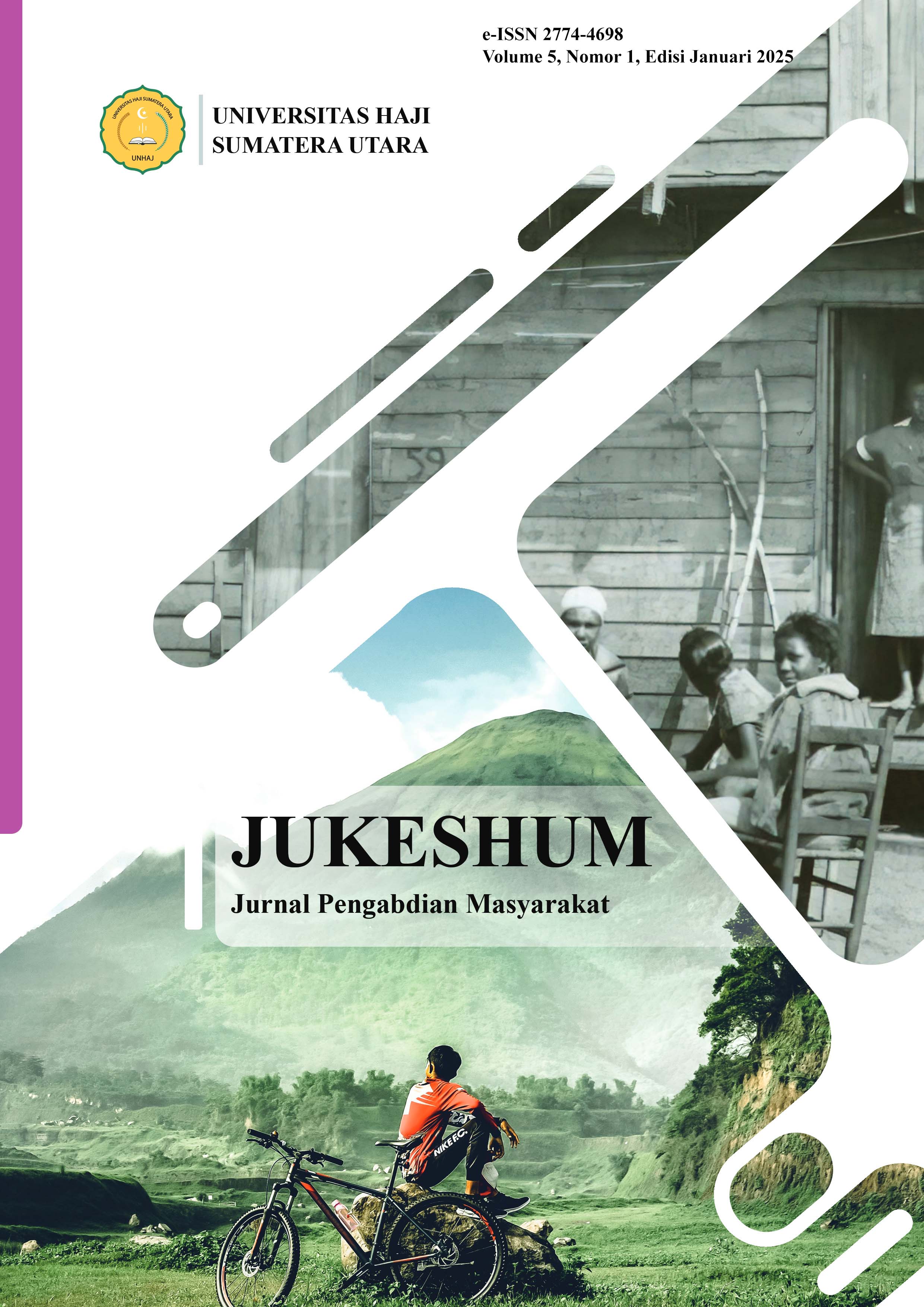Improving Teenagers' Self-Capacity Towards Zero Stunting Through The Implementation Of The "Si-Telur Petis" Application As A Screening For Non-Communicable Diseases In Selopamioro Village
Peningkatan Kapasitas Diri Remaja Menuju Zero Stunting Melalui Implementasi Aplikasi “Si-Telur Petis” Sebagai Skrining Penyakit Tidak Menular di Kelurahan Selopamioro
DOI:
https://doi.org/10.51771/jukeshum.v5i1.1229Keywords:
Telenursing application, Self-capacity, Non-communicable diseases, Adolescence, StuntingAbstract
The demands of learning tasks for today's teenagers spend a lot of time on activities using gadgets while less physical activity, and less healthy eating patterns. This condition is one of the causes of the high incidence of anemia, hypertension and diabetes mellitus in adolescence. The purpose of this community service is to realize healthy adolescents by increasing the capacity of adolescents both knowledge and skills in the Prevention of non-communicable diseases using the application “Si-Telur Petis”. The method of dedication is carried out by training on the use of the ‘Si-Telur Petis” application, screening for non-communicable diseases, namely anemia, hypertension and diabetes mellitus, mentoring of adolescent cadres for home visits. It was found that the activities carried out increased knowledge by 88% in adolescents regarding the Prevention of non-communicable diseases, improved skills of adolescent cadres in screening 70%, understanding of adolescent cadres in using and accessing the application “Si-Telur Petis” 100%, confident adolescent cadres make home visits. The continuity of the implementation of Posyandu remaja needs support and assistance from the local health center. Increasing the self-capacity of adolescents is the key in preventing non-communicable diseases so that superior generations are realized.
References
Biro Komunikasi dan Pelayanan Masyarakat. (2022). Tiga Upaya Kemenkes Turunkan Stunting di Indonesia. Sehatnegeriku.Kemkes.Go.Id. https://sehatnegeriku.kemkes.go.id/baca/umum/20220811/4640923/tiga-upaya-kemenkes-turunkan-stunting-di-indonesia/
Dewi, K. I. T., Bekti, H. S., Krisna, L. A. W., & Dewi, N. N. A. (2023). Gambaran kadar hemoglobin pada remaja putri. Jurnal Skala Husada: The Journal of Health, 20(2), 8–14.
Direktorat Jenderal Pelayanan Kesehatan. (2022). Penyakit Tidak Menular. Yankes.Kemkes.Gi.Id. https://yankes.kemkes.go.id/view_artikel/761/penyakit-tidak-menular-ptm
Giyanti, F. (2016). Pengaruh pemberian tablet Fe terhadap kenaikan kadar hemoglobin remaja putri dengan anemia di SMK Negeri I Ponjong GunungKidul.
Intening, V. R., Sinaga, M. R. E., Listyaningsih, E., Indrayanti, & Isnanto. (2024). Optimalisasi peran kader dalam promosi pencegahan penyakit tidak menular melalui manajemen kunjungan rumah. Jukeshum: Jurnal Pengabdian Masyarakat, 4(2), 226–230.
Kementerian Kesehatan Indonesia. (2022). Kategori Usia Remaja. Ayosehat.Kemkes.Go.Id. https://ayosehat.kemkes.go.id/kategori-usia/remaja
Ministry Of Health Of The Republic Of Indonesia. (2019). Profil Kesehatan Indonesia tahun 2018 [Indonesia Health Profile 2018].
Misbah, S. R., Rusna, T., & Sulupadang, P. (2023). Aplikasi e-PTM sebagai Media Skrining Faktor Risiko Penyakit Tidak Menular Pada Remaja. Healh Information: Jurnal Penelitian, 15(3).
Pratiwi, R. Y. (2013). IDAI | Kesehatan Remaja di Indonesia. The2nd Adolescent Health National Symposia: Current Challenges in Management. https://www.idai.or.id/artikel/seputar-kesehatan-anak/kesehatan-remaja-di-indonesia
Riswana, I., & Mulyani, N. S. (2022). Faktor risiko yang mempengaruhi kadar asam urat penderita hiperurisemia di Wilayah Kerja Puskesmas Muara Satu Kota Lhokseumawe. Darusasalam Nutrition Journal, 6(1), 29–36.
Simanjuntak, J. (2018). Hubungan kadar hemoglobin pada remaja putri dengan hasil belajar di MTS Assalam Wilayah Kerja Puskesmas Rimbo Bujang II Tahun 2018. Scientia Journal, 7(2), 61–66.
Sinaga, M. R. E., Indrayanti, I., & Irfan, M. (2022). Behavior prevention modification on non-communicable diseases during Covid-19 pandemic using android-based telenursing apllication “SI-TELUR PETIS.” Comprehensive Nursing Journal, 8(2, April).
Sinaga, M. R. E., Wirata, R. B., & Istianti, D. W. (2024). Peningkatan Kapasitas Diri Remaja Melalui Pendekatan Community Participatory Menuju Desa Bebas Stunting di Kelurahan Selopamioro. Jukeshum: Jurnal Pengabdian Masyarakat, 4(1), 78–85.
Sistem Informasi Desa/SID. (2023). Profil Kalurahan Selopamioro. Profil Desa Kalurahan Selopamioro. https://selopamioro.bantulkab.go.id/first
Sumarwati, M., Mulyono, W. A., Nani, D., Swasti, K. G., & Abdilah, H. A. (2022). Pendidikan kesehatan tentang gaya hidup sehat pada remaja tahap akhir. Jurnal ABDIMAS BSI, 5(1), 36–48.
The Yogyakarta City Health Office. (2020). Profil kesehatan Daerah Istimewa Yogyakarta tahun 2019 [Health profile of Yogyakarta Special Region 2019].
Ulya, N., Sibuea, A. Z. E., Purba, S. S., Maharani, A. I., & Herbawani, C. K. (2023). Analisis faktor risiko diabetes pada remaja di Indonesia. Jurnal Kesehatan Tambusai, 4(3), 2332–2341.
UNICEF. (2021). Profil Remaja 2021 (Vol. 917, Issue Mei).
Widodo, D., Retnaningtyas, E., & Fajar, I. (2012). Faktor risiko timbulnya diabetes mellitus pada remaja SMU. Jurnal Ners, 7(1), 37–46.
World Health Organization. (2019). Noncommunicable diseases in South-East Asia. https://www.who.int/southeastasia/health-topics/noncommunicable-diseases
Downloads
Published
Issue
Section
License
Copyright (c) 2025 Mei Rianita Elfrida Sinaga, Daning Widi Istianti, Resta Betaliani Wirata

This work is licensed under a Creative Commons Attribution-ShareAlike 4.0 International License.
Hak Cipta dan Lisensi
Penulis yang mempublikasikan naskahnya melalui Jukeshum: Jurnal Pengabdian Masyarakat menyetujui beberapa hal berikut:
- Hak Cipta atas naskah-naskah karya ilmiah di dalam Jurnal ini dipegang oleh Penulis.
- Penulis menyerahkan hak saat pertama kali mempublikasi Naskah karya ilmiahnya dan secara bersamaan Penulis memberikan izin/lisensi dengan mengacu pada Creative Commons Attribution-ShareAlike 4.0 International License kepada pihak lain untuk menyebarkan karya ilmiahnya tersebut dengan tetap mencantumkan penghargaan bagi penulis dan Jukeshum: Jurnal Pengabdian Masyarakat sebagai media Publikasi pertama atas karya tersebut.
- Hal-hal yang berkaitan dengan non-eksklusivitas pendistribusian Jurnal yang menerbitkan karya ilmiah penulis dapat diperjanjikan secara terpisah (contoh: permintaan untuk menempatkan karya yang dimaksud pada perpustakaan suatu institusi atau menerbitkannya sebagai buku) dengan Penulis sebagai salah satu pihak perjanjian dan dengan penghargaan pada Jukeshum: Jurnal Pengabdian Masyarakat sebagai media publikasi pertama atas karya dimaksud.
- Penulis dapat dan diharapkan untuk mengumumkan karyanya secara online (misalnya pada Repositori atau pada laman Organisai/Institusinya) sejak sebelum dan selama proses pengumpulan naskah, sebab upaya tersebut dapat meningkatkan pertukaran citasi lebih awal dan dengan cakupan yang lebih luas.








